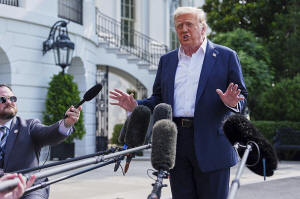From tariffs to universities, Trump’s negotiating style is often less
dealmaking and more coercion
[July 14, 2025]
By CHRIS MEGERIAN, JOSH BOAK and COLLIN BINKLEY
WASHINGTON (AP) — President Donald Trump prides himself on being a
dealmaker, but his negotiating style is more ultimatum than compromise.
In the last week, Trump has slapped trading partners with tariffs rather
than slog through prolonged talks to reach agreements. He ratcheted up
the pressure on the Federal Reserve to cut interest rates. And his
administration launched a new investigation into higher education as he
tries to reshape universities.
For Trump, a deal isn’t necessarily agreement in which two sides
compromise — it’s an opportunity to bend others to his will. While Trump
occasionally backs down from his threats, the past week is a reminder
that they are a permanent feature of his presidency.
As Trump tightens his grip on independent institutions, there are fewer
checks on his power. Republicans in Congress fear primary challenges
backed by the president, and the Supreme Court is stocked with
appointees from his first term.
Trump recently summed up his approach when talking to reporters about
trade talks with other countries. “They don’t set the deal," he said. "I
set the deal.”
Trump’s allies believe his aggression is required in a political
ecosystem where he's under siege from Democrats, the court system and
the media. In their view, the president is simply trying to fulfill the
agenda that he was elected to achieve.

But critics fear he's eroding the country’s democratic foundations with
an authoritarian style. They say the president's focus on negotiations
is a facade for attempts to dominate his opponents and expand his power.
“Pluralism and a diversity of institutions operating with autonomy —
companies, the judiciary, nonprofit institutions that are important
elements of society — are much of what defines real democracy,” said
Larry Summers, a former Treasury secretary and former president of
Harvard University. “That is threatened by heavy handed, extortionist
approaches.”
Seeking control of higher education
Harvard has been a top target for Trump, starting in April when he
demanded changes to the university's governance and new faculty members
to counteract liberal bias.
As Harvard resisted, administration officials terminated $2.2 billion in
federal grants. The money is the lifeblood of the university's sprawling
research operation, which includes studies on cancer, Parkinson's
disease, space travel and pandemic preparedness.
Trump has also attempted to block Harvard from hosting roughly 7,000
foreign students, and he's threatened to revoke its tax-exempt status.
His administration recently sent subpoenas asking for student data.
“They’ll absolutely reach a deal," Trump said Wednesday.
Administration officials also pulled $175 million from the University of
Pennsylvania in March over a dispute around women's sports. They
restored it when school officials agreed to update records set by
transgender swimmer Lia Thomas and change their policies.
Columbia University bent to Trump by putting its Middle East studies
department under new supervision, among other changes, after the
administration pulled $400 million in federal funding. At the University
of Virginia, President James Ryan resigned under pressure following a
Justice Department investigation into diversity, equity and inclusion
practices. A similar investigation was opened Thursday at George Mason
University.
“Federal funding is a privilege, not a right, for colleges and
universities," said Kush Desai, a White House spokesman.

Such steps were unheard of before Trump took office. Ted Mitchell,
president of the American Council on Education and an Education
Department official under President Barack Obama, said Trump isn't
seeking deals but is “demanding more and more and more.”
"Institutional autonomy is an important part of what makes higher
education work," he said. “It’s what enables universities to pursue the
truth without political considerations.”
[to top of second column]
|

President Donald Trump speaks with reporters before departing the
White House, Friday, July 11, 2025, in Washington. (AP Photo/Evan
Vucci)

Going after the Federal Reserve's independence
The Fed has also faced Trump's wrath. He blames Fed Chair Jerome
Powell for moving too slowly to cut interest rates, which could make
consumer debt like mortgages and auto loans more affordable. It
could also help the U.S. government finance the federal debt that's
expected to climb from the tax cuts that Trump recently signed into
law.
Powell has held off on cutting the central bank's benchmark rate, as
Trump's tariffs could possibly worsen inflation and lower rates
could intensify that problem. Desai said the White House believes
the Fed should act based on what the data currently shows, which is
that "President Trump’s policies have swiftly tamed inflation.”
Although Trump has said he won't try to fire Powell — a step that
might be impossible under the law anyway — he's called on him to
resign. In addition, Trump's allies have increased their scrutiny of
Powell's management, particularly an expensive renovation of the
central bank's headquarters.
David Wessel, a senior fellow in economic studies at the Brookings
Institution, said Trump's approach could undermine the Fed's
credibility by casting a political shadow over its decisions.
“There will be real costs if markets and global investors think the
Fed has been beaten into submission by Trump," he said.
Tariff threats instead of trade deals
Trump originally wanted to enact sweeping tariffs in April. In his
view, import taxes would fix the challenge of the U.S. buying too
much from other countries and not selling enough overseas.
After a backlash in financial markets, Trump instituted a
three-month negotiating period on tariffs. Peter Navarro, one of his
advisers, said the goal was “90 deals in 90 days.”
The administration announced a few trade frameworks with the United
Kingdom and Vietnam, but Trump ran out of patience. He's sent
letters to two dozen nations and the European Union informing them
of their tariff rates, such as 30% against the EU and Mexico,
potentially undercutting the work of his own negotiators.

Desai said Trump's approach has generated “overwhelming interest”
from other countries in reaching trade deals and gives the U.S.
leverage in negotiations.
John C. Brown, a professor emeritus of economics at Clark University
in Massachusetts, said the “willy-nilly setting of tariffs according
to one person’s whims has no precedence in the history of trade
policy since the 17th century.”
“It’s just bizarre,” Brown said of Trump’s moves. “No one has done
this in history.”
The president has also used the threat of tariffs in an attempt to
help political allies and influence other countries' court systems.
He told Brazil that he would implement a 50% tariff if the country
didn't drop its prosecution of former President Jair Bolsonaro, who
like Trump was charged with trying to overturn an election.
Inu Manak, a fellow on trade policy at the Council on Foreign
Relations, said Trump's inconsistent approach will foster distrust
of U.S. motives.
She noted that two of the letters went to Canada and South Korea,
allies who have existing trade agreements with the U.S. approved by
Congress.
By imposing new tariffs, she said, Trump is raising “serious
questions about the meaning of signing any deal with the United
States at all.”
All contents © copyright 2025 Associated Press. All rights reserved |